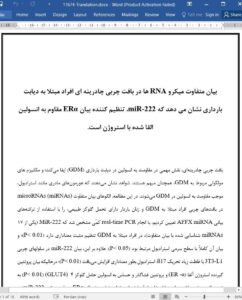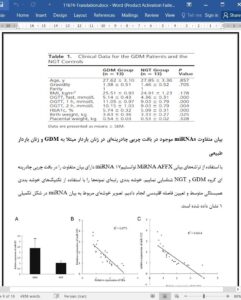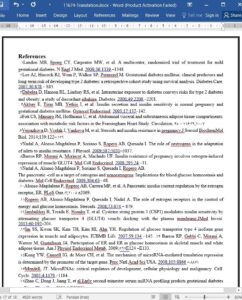Omental adipose tissue plays a central role in insulin resistance in gestational diabetes mellitus (GDM), and themolecularmechanisms leading to GDM remains vague. Evidence demonstrates that maternal hormones, such as estradiol, contribute to insulin resistance in GDM. In this study we determined the differential expression patterns of microRNAs (miRNAs) in omental adipose tissues from GDM patients and pregnant women with normal glucose tolerance using AFFX miRNA expression chips. MiR-222, 1 of 17 identified differentially expressed miRNAs, was found to be significantly up-regulated in GDM by quantitative real-time PCR (P � .01), and its expression was closely related with serum estradiol level (P � .05). Furthermore, miR-222 expression was significantly increased in 3T3-L1 adipocytes with a high concentration of 17�-estradiol stimulation (P � .01), whereas the expressions of estrogen receptor (ER)- protein and insulin-sensitive membrane transporter glucose transporter 4 (GLUT4) protein (P � .01) were markedly reduced. In addition, ER was shown to be a direct target of miR-222 in 3T3-L1 adipocytes by using the luciferase assay. Finally, antisense oligonucleotides of miR-222 transfection was used to silence miR-222 in 3T3-L1 adipocytes. The results showed that the expressions of ER and GLUT4, the insulin-stimulated translocation of GLUT4 from the cytoplasm to the cell membrane and glucose uptake in mature adipocytes were dramatically increased (P � .01). In conclusion, miR-222 is a potential regulator of ER expression in estrogen-induced insulin resistance in GDM and might be a candidate biomarker and therapeutic target for GDM.
Gestational diabetes mellitus (GDM), defined as glucose intolerance that is first recognized during pregnancy, is one of the most common pregnancy complications and affects approximately 1%-14% of all pregnancies (1). Women with GDM have a high risk of other pregnancy complications, including gestational hypertension, macrosomia, and diabetic ketoacidosis, and are more likely to suffer from type 2 diabetes after the pregnancy. The offspring of GDM mothers are at a higher risk of metabolic diseases, such as diabetes, obesity, and cardiovascular disease, in their adult lives (2, 3).











